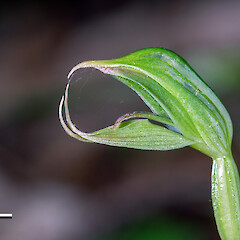Pterostylis porrecta
Common name
shrimp-flowered greenhood
Synonyms
None (first described in 1997)
Family
Orchidaceae
Flora category
Vascular – Native
Endemic taxon
Yes
Endemic genus
No
Endemic family
No
Structural class
Orchids
NVS code
The National Vegetation Survey (NVS) Databank is a physical archive and electronic databank containing records of over 94,000 vegetation survey plots - including data from over 19,000 permanent plots. NVS maintains a standard set of species code abbreviations that correspond to standard scientific plant names from the Ngä Tipu o Aotearoa - New Zealand Plants database.
PTEPOR
Chromosome number
2n = 44
Current conservation status
The conservation status of all known New Zealand vascular plant taxa at the rank of species and below were reassessed in 2017 using the New Zealand Threat Classification System (NZTCS) – more information about this can be found on the NZTCS website. This report includes a statistical summary and brief notes on changes since 2012 and replaces all previous NZTCS lists for vascular plants.
Please note, threat classifications are often suggested by authors when publications fall between NZTCS assessment periods – an interim threat classification status has not been assessed by the NZTCS panel.
- Conservation status of New Zealand indigenous vascular plants, 2017 . 2018. Peter J. de Lange, Jeremy R. Rolfe, John W. Barkla, Shannel P. Courtney, Paul D. Champion, Leon R. Perrie, Sarah M. Beadel, Kerry A. Ford, Ilse Breitwieser, Ines Schönberger, Rowan Hindmarsh-Walls, Peter B. Heenan and Kate Ladley. Department of Conservation. Source: NZTCS and licensed by DOC for reuse under the Creative Commons Attribution 4.0 International licence.
2017 | At Risk – Naturally Uncommon | Qualifiers: Sp
Previous conservation statuses
2012 | At Risk – Naturally Uncommon | Qualifiers: Sp
2009 | At Risk – Naturally Uncommon
2004 | Sparse
Distribution
Endemic. New Zealand: North Island, South Island.
Habitat
Lowland to montane. Usually in deeply shaded, damp scrub and light forest. Also on ultramafic rock.
Detailed description
Terrestrial tuberous herb growing in diffuse colonies. Sterile plants 20–50 mm tall, 3–4-leaved; leaves linear to linear-lanceolate, 40–70 × 4–6 mm, dark green, margins entire, apex acute to acuminate. Flowering plants 60–200 mm tall. Leaves 4–5, cauline, obliquely erect to spreading, sometimes arcuate; lamina linear-lanceolate, 45–120 × 4–6 mm, sessile, sheathing at the base; margins entire; apex acute to acuminate. Pedicel 10 mm long, slender. Ovary narrowly ellipsoid, 7–10 mm long, yellow-green, ribbed. Flower solitary, 18–22 mm long, semi-nodding, translucent white and pale green, darker towards the tip of the galea, the points of the sepals pale pink; galea shallowly gibbous at the base then leaning forwards before decurving in a shallow curve to the apex, the dorsal sepal much longer than the petals. Dorsal sepal ovate-lanceolate in outline when flattened, 19–22 × 9–11 mm, prominently expanded in the proximal third then gradually tapered to the acuminate apex. Lateral sepals obliquely erect top nearly horizontal, held well away from the galea, leaving a very wide lateral gap to the marginal petals; most of the labellum visible from the side through this gap; upper part of sinus flat when viewed from the side, sloping to a broad v when viewed from the front; internally the sinus projecting inwards as a small platform-like structure; conjoined part 7–9 × 5–6 mm wide at the top, narrowed to 1.6 mm wide at the base, the margins inrolled towards the apex and tapered into the free points, the free points 13–15 mm long, narrowly tapered to an attenuate apex, curved forwards, the tips often shallowly curved. Petals oblong-lanceolate, 16–19 × 3.0–3.5 mm, nearly straight, acute to acuminate, green with a white central area and two or three green stripes; flange vestigial. Labellum obliquely erect, shallowly curved forwards distally, the apex not protruding through the sinus in the set position; labellum hinge ligulate, 3 × 1 mm; lamina oblong, 8.0–9.0 × 2.3–2.5 mm, green to brownish green with a darker green central callus, apex obtuse, pinkish; callus 0.5 mm wide near the apex, raised; basal appendage 2.6–3.0 mm long, decurved. apex penicillate. Column 10–12 mm long, bent away from the ovary at about 50 degrees at the base then obliquely erect, green and white;column foot 3 mm long. Column-wings 4.5–5.0 mm long; basal lobe 2.0 × 0.7 mm, at an angle of 40 degrees, apex broadly obtuse, inner margins incurved, sparsely ciliate; mid-section 1.5 mm long, green; apical lobe 0.8 mm long, obtuse. Anther 1 mm long, shortly rostrate. Pollinia linear-clavate, 1.0–1.2 mm long, yellow, mealy. Stigma narrowly scutiform, 5.0–5.5 × 1.0–1.4 mm, situated just below column-wings raised. Capsule subcylindrical to broadly ellipsoid, 8–14 × 4–6 mm, initially yellow-green maturing grey.
Manaaki Whenua Online Interactive Key
Similar taxa
Recognised by the small, semi-nodding, pale green and white flowers; by the lateral sepals being obliquely erect to nearly horizontal and held well away from the galea leaving a wide lateral gap exposing most of the labellum in the set position; by the pale pink narrowly tapered free points of the lateral sepals with the tips curled forwards; and by the straight petal; and oblong labellum.
Flowering
November–January
Flower colours
Green, White
Fruiting
January–March
Propagation technique
Difficult—should not be removed from the wild.
Threats
A biologically sparse species, known from widely scattered sites. It is possibly threatened by plant collectors.
Etymology
pterostylis: Winged column
Where To Buy
Not commercially available
Attribution
Fact Sheet prepared for NZPCN by P.J. de Lange 14 April 2007: Description based on Jones et al. (1997).
References and further reading
Jones DL, Molloy BPJ, Clements MA. 1997. Six new species of Pterostylis R.Br. (Orchidaceae) from New Zealand. The Orchadian 12: 266–281.
NZPCN Fact Sheet citation
Please cite as: de Lange, P.J. (Year at time of access): Pterostylis porrecta Fact Sheet (content continuously updated). New Zealand Plant Conservation Network. https://www.nzpcn.org.nz/flora/species/pterostylis-porrecta/ (Date website was queried)














